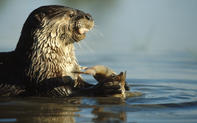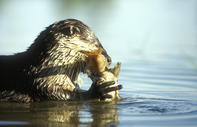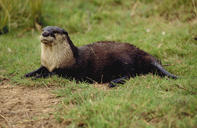The Cape clawless otter (Aonyx Capensis) derives its name from the fact that its front feet are adapted to digging and therefore clawless. The hind feet are partly webbed with three claws on each foot. They are the most widely distributed otter species in southern Africa, living in all the major river systems and many of the minor watercourses.

Freshwater is an essential habitat requirement, according to a conservation assessment of Aonyx capensis, not only for drinking but also because otters do not have a subcutaneous layer of fat and therefore have to rinse their dense fur for thermoregulation. Cape clawless otters are quite large, growing up to two meters tall and weighing between 10 kg and 21 kg.
Their lips, chin, throat, ears and upper chest are white, with long grey-white whiskers and light to dark brown fur that appears black when wet. Their tails, which can be up to 50 cm long, are used to support them when they sit on their hind legs and to propel them through the water when swimming. They arch their back when walking on land.
Cape Clawless Otters, are generally solitary animals that live within a territory with family groups of up to five individuals. Each individual has their own home range and keeps to themselves until the breeding season in December.
About one to three pups are born after a two month gestation period. The pups are raised by their mothers and stay with her until they reach sexual maturity when they are a year old. The pups are weaned when they are about 60 days old.
Killing and Feeding Pattern

Cape Clawless Otters are most active at dawn and dusk, depending on where they live. In the Drakensberg, for example, they are often seen foraging from mid-afternoon, whereas they are more active at night to avoid contact with humans and dogs in unprotected areas in the Cape Peninsula and Gauteng.
Hunting may, however, be done at any time of the day. They usually live on small prey, such as fish, crabs, frogs or insects, but may become a nuisance on poultry or fish farms where they will often kill more animals than needed.
Lambs may also fall victim to Cape clawless otters, with the prey usually suffocating to death after its nose has been bitten off. The otters may feed on the nose, ears and lips of the lamb and sometimes also the chest.
Management

Farmers are advised, by the Predation Management Forum's manual, to prevent losses with wire netting to a height of a metre, as well as electric fencing placed about 45 cm from the ground.
Kraaling at night, the use of a shepherd and guard animals may also help to keep vulnerable animals safe.
Farmers should inquire about a permit from the relevant authorities if they want to catch an otter with a cage trap. The manual advises farmers to put a tennis ball in the cage to keep the otters busy when they are caught to prevent injuries.
By Glenneis Kriel